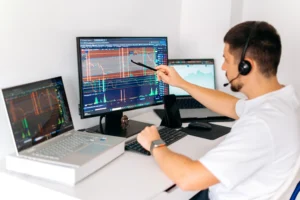A strong pre-market routine isn’t optional—it’s essential for traders aiming to perform consistently. Every successful day in the market begins with thoughtful preparation. Before you even consider entering a trade, you must complete your daily trading preparation. This involves understanding global sentiment, identifying opportunity zones, and defining a structured pre-market trading strategy.
If you skip this crucial process, you rely on emotion instead of planning. In contrast, traders who begin each morning with a clear and repeatable process build real trading discipline. That discipline directly impacts your profitability over the long term.
Let’s dive deep into each step of the process and explore how you can master your pre-market hours for optimal results.
Start With Global Market Overview and Sentiment Reading
Every reliable pre-market routine starts with reviewing global financial behaviour. Markets never sleep, so your routine must begin by understanding what happened overnight.
Begin by checking Asian and European market movements. Watch for big price swings, sudden news events, or high-volume sessions. These early indicators shape the tone of the upcoming trading day.
Next, analyse sentiment. Look for signs of fear, greed, or caution in the market. Sentiment tells you whether traders are risk-on or risk-off. For example, if Asian equities are red and European indices fall, risk sentiment is likely negative.
Now turn to the economic calendar. Identify upcoming reports that can create volatility. Events like Federal Reserve announcements or inflation updates require special attention during your market opening analysis. Knowing what lies ahead allows you to time your entries with more precision.
Always consider how overnight moves connect to your strategy. For example, if the dollar weakens after dovish central bank comments, plan for continued downside in USD pairs. Understanding global momentum is critical for effective daily trading preparation.
Draw Fresh Technical Levels Before the Market Opens
Once you’ve studied global sentiment, it’s time to clean your charts. Erase old trendlines. Recalculate zones using the most recent price behaviour. This is where your pre-market trading strategy takes shape visually.
Mark these levels:
- Key highs and lows from the previous session
- Major supply and demand zones
- Breakout points from overnight price action
- Pre-market price gaps or unfilled liquidity zones
Do not skip this step. Updated technical zones guide your reaction to price. If you don’t mark them ahead of time, you’ll be forced to guess under pressure.
Each session creates new structures. A reliable pre-market routine requires identifying them early. This ensures you know where price might bounce, stall, or reverse during peak volume hours.
When your charts are aligned with price behaviour, your confidence increases. That confidence becomes fuel for consistent execution.
Assess Currency Strength and Intermarket Trends
In addition to reading the charts, examine currency strength and broader market correlations. This step connects your setups to real momentum.
Use a strength meter or price action of major pairs to identify trending currencies. Ask yourself: which currency is dominating today? Is USD losing ground across the board? Is JPY gaining strength during risk-off sessions?
Next, assess correlation between markets. Often, strength in commodities affects related currencies. If oil is rising, CAD may also gain strength. If gold falls sharply, AUD might follow.
This insight shapes your pre-market trading strategy by identifying which pairs are best suited for trend-based trades.
You must align your plan with the active flows. If you notice that EUR, GBP, and AUD are all strong against the dollar, it suggests broader USD weakness. Your setups should reflect that. It’s not just about charts—it’s about context.
When strength analysis aligns with technical levels, your trades become more logical and higher probability.
Create Structured Trade Scenarios Before Market Open
Now that you’ve prepared the technicals and macro view, it’s time to plan execution. Before entering any trade, prepare multiple trade scenarios. This solidifies your daily trading preparation.
Each scenario should include:
- The exact condition that will trigger your entry
- Your target based on the next level or range
- Your stop-loss placement
- Conditions that would invalidate the setup
Let’s say the EURUSD is trading near resistance. Your plan may be: “If EURUSD breaks and closes above 1.0900, I’ll enter long with a target at 1.1000 and a stop-loss at 1.0850.”
You’re not guessing. You’re executing a plan you made calmly during your pre-market routine. This mental clarity reduces hesitation and helps you follow your edge.
The purpose is to make decisions before the pressure builds. Clear plans made in advance outperform emotional trades made during live markets.
Prepare Mentally and Emotionally for the Trading Day
Technical skills are not enough. Mental clarity is equally essential for traders. As part of your pre-market routine, reflect on your emotional state.
Ask yourself:
- Am I mentally alert and focused today?
- Do I feel rushed, tired, or overly confident?
- Can I follow my plan without distraction?
If you feel emotionally unstable, reduce your position size or skip the session altogether. Self-awareness protects your capital more than any tool.
Also, briefly review your journal from the previous day. Learn what worked and what didn’t. This is part of intentional trading day planning. When you recognise emotional triggers early, you can avoid costly mistakes later.
The goal is to trade with control, not impulse. And that starts with checking in on your mindset every morning.
Set Up Charts, Alerts, and Execution Tools
With your strategy in place, organise your trading station. This ensures smooth performance when opportunity arrives. A messy platform leads to mistakes. A clean one supports flow.
Do this every morning:
- Load your top watchlist pairs or instruments.
- Mark the key levels on each chart.
- Set alerts at breakout or reaction zones.
- Make sure indicators and trading tools are functioning.
Keep only relevant tabs open. Remove distractions. This step prepares your environment for battle. When your tools are ready, your mind remains focused.
Great execution requires both mental and technical readiness. The more organised your platform, the more effective your pre-market trading strategy becomes during volatile moments.
Establish Your Daily Risk Plan Before Trading Begins
Risk control should never be reactive. It must be built into your pre-market routine from the start. Set limits while your mind is clear, not during market chaos.
Define the following:
- How much capital you’re willing to risk today
- How many trades you’ll allow yourself
- The maximum drawdown you can tolerate
- Criteria for ending your session early
For example, if your rule is “Stop trading after two consecutive losses”, you must respect it without exception. This protects your capital and mental health.
These boundaries are not restrictions—they are protections. They make your process repeatable and sustainable over time.
Without rules, every loss feels personal. With a risk framework, every trade becomes part of a bigger picture. That mindset is the key to long-term consistency.
Perform a Last-Minute Market Opening Analysis
Finally, just before the market opens, take five minutes for a last scan. Use this time to confirm that your earlier analysis still holds.
Watch for:
- Sharp pre-market moves that violate key zones
- Reactions to early economic news
- Shifts in market volume or volatility
If something has changed, update your plan. If everything aligns, be ready to execute.
This final Market Opening Analysis ensures your pre-market routine remains connected to real-time developments. It’s your last chance to refine your strategy before the bell rings.
Trust your preparation. Don’t chase trades. Let the setups you planned come to you.
Final Words: Your Edge Is Built Before the Market Opens
In the fast-paced world of trading, your real edge doesn’t come from indicators. It comes from how you prepare. A structured pre-market routine turns chaos into clarity. It transforms uncertainty into confident decision-making.
When you focus on structured daily trading preparation, your results become repeatable. Your losses feel controlled. Your wins feel earned.
Every winning trader knows that success starts hours before the market opens. Follow a consistent routine. Use a tested pre-market trading strategy. Never skip your morning process. Over time, it will shape you into a more professional and disciplined trader.
Read here to learn more about “Multi-Pair Forex Risk Management for Daily Traders“

I’m Chaitali Sethi — a seasoned financial writer and strategist specializing in Forex trading, market behavior, and trader psychology. With a deep understanding of global markets and economic trends, I simplify complex financial concepts into clear, actionable insights that empower traders at every level. Whether it’s dissecting winning strategies, breaking down market sentiment, or helping traders build the right mindset, my content bridges the gap between information and implementation.




